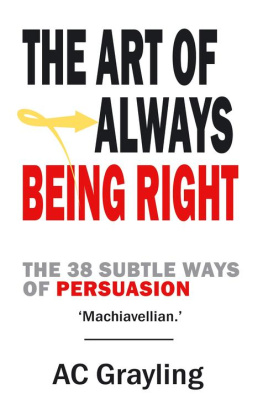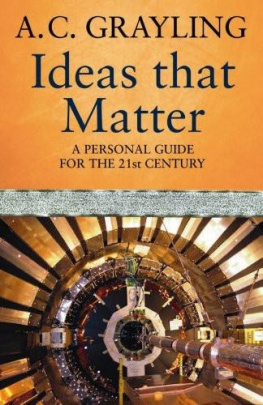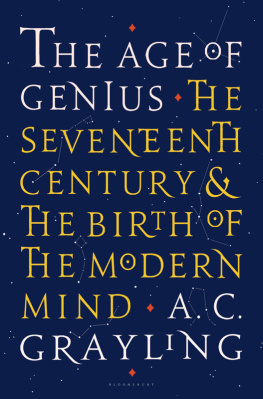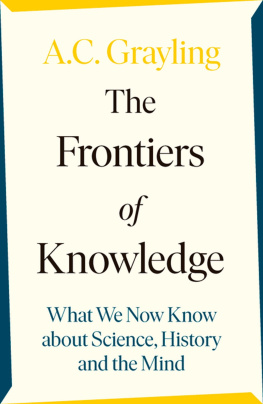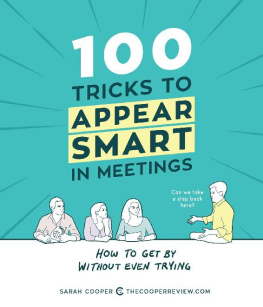Beguiling.
Drily witty essay.
An instruction manual no one can afford to be without.
Beware who you give this book to.
I wish I had read it earlier A slim but perfectly formed volume warmly recommended.
I recommend that you keep this delightful essay at your side.
The entire gamut of lawyers tricks.
In discussions and meetings the aim of everyone is to persuade. Yet we know really that the best result is obtained by the person who is most skilled in holding his position. The Art of Always Being Right catalogues the 38 subtle tricks businessmen, negotiators, politicians, lawyers use to gain advantage. It may well be that you are in the right. But once you enter into a debate with someone else being right is not enough-you are entirely on your own. You need to parry moves designed to throw you. This book will teach you all you need to know.
AC Grayling is Master of New College of the Humanities, London and is a Fellow of St Annes, Oxford. He reviews regularly in the Financial Times. He has a regular column in Prospect and The Times.
Arthur Schopenhauer is one of the worlds most widely read philosophers.
A.C. Grayling
In an ideal world discussion and debate would be aimed at truth, or at least agreement. In such a world the desire of every well-intentioned person would be to identify worthwhile goals and the best means of attaining them; and they would strive to solve problems by co-operation, and to overcome disagreements and conflicts.
But the real world is anything but ideal, and in it people strive not to reach truth, but to win arguments; nor do they seek what is best for everyone, but only what is best for themselves. For the great majority of people self-interest is a more powerful motivator than altruism, and as a result they grab any means to get their noses ahead in the competition of life.
So insistent is the human desire to win that almost as soon as the philosophers of classical Greece began to undertake serious enquiry into the nature of things, so also began the art of rhetoric, which is the technique of winning arguments independently of truth or merit.
Nothing has since changed. In Parliament and the press, our adversarial system of challenge and accusation, defence and counter-attack, requires that anyone engaged in public life has to be fully equipped with the skills of rhetoric. To admit a political charge or a tabloid smear story is unthinkable; every tool of casuistry has to be brought into play to defend oneselfwriggling out of a tough corner, evading questions, answering with plausible vagueness, deflecting, twisting and dodging, and trying to sound honest while being the opposite. Such is the stuff of discourse in much political and public life, which as a result is too often not an arena of debate but of debasement
The people who invented the dubious art of argument-winning even if it means making the worse case seem the better were the Sophists of ancient Greece, despised by Socrates and his equally famous pupil Plato because they cared nothing for truth, and (even worse, in Socrates view) charged fees to teach their tricks.
The Sophists were never short of clients, because success in their ancient city states depended on oratorical skills. Every adult male was a member of the governing body, and each had to undertake his own legal cases when need arose. A class of script-writers arose who, for a fee, would provide speeches for any occasion; but that did not reduce the premium on rhetoric, which rapidly came to be organised as a science by its first teachers.
Arthur Schopenhauer, one of the great philosophers of the nineteenth century, recognised all the tricks and dishonesties of rhetoric at work in his own way because he had a profound scholarly grasp of rhetorics classical tradition. He saw it at work in the specious arguments of politicians and pretenders of all kinds, and in response wrote his acidulous Art of Always Being Right.
This startling little tract presents itself as an instruction booklet on how to beat any adversary in debate. Controversial dialectic, Schopenhauer wrote, deliberately suppressing any tincture of irony, is the art of disputing, and of disputing in such a way as to hold ones own, whether one is right or wrong. And as if to make his readers doubly sure that he meant this in deadly earnest, he added, in debating we must put objective truth aside, or rather, we must regard it as an accidental circumstance, and look only to the defence of our own position and the refutation of our opponents.
Of course Schopenhauers real intention was to alert his readers to the tricks that othersfrom politicians to partisan newspapers, from advertisers to sellers of various forms of snake-oilare only too keen to use. Under the guise of teaching chicanery (his own later word for rhetoric), he effectively taught how to recognise it and therefore defend against it. And his incisive little book remains a valuable tool to this end today.
The debating tricks Schopenhauer describes are various. Make your opponent angry, attack him rather than his argument; ask him so many different questions that you confuse him; when he denies a proposition, put it in its converse form so that he affirms it; use subtle distinctions and arcane definitions to obscure the issue; make your opponent agree to a number of true propositions and then insert among them the proposition you wish him to accept; quickly distract your opponent from any line of argument that you can see will defeat you, by introducing alternative lines of thoughtand so on and on, for dozens of sly tricks aimed at winning the argument no matter what.
Despite Schopenhauers air of seriousness in describing and explaining these scurrilities, and despite his generally pessimistic view of human nature and the world, he was decidedly against rhetoric. The motto he chose for himself was vitam impendere vero, dedicate life to truth, and his little treatise on the tricks of argument is a way of following that command, for it shows precisely what one must not do if one is to think truly and argue honestly.
Like so much of what Schopenhauer wrote, The Art of Always Being Right is full of wisdom and sly humour, and it is one of the best inoculations against crooked thinking that has ever been written.
A.C. Grayling
When Schopenhauer wrote his essay The Art of Always Being Right, did he intend it to be an exercise in irony? It offers pungent practical advice on how to beat an adversary in debate, and the advice it gives is unapologetically Machiavellian. Controversial dialectic, he writes, is the art of disputing, and of disputing in such a way as to hold ones own, whether one is right or wrong. He here deliberatelyand if non-ironically, then provocativelyechoes those sophists of classical antiquity who, on the negative view of them encouraged by Socrates and Plato, offered to teach anyone the art of making the worst case seem the better and the better case seem the worst, independently of truth and justiceand for a fee.
Socrates and Plato accordingly had nothing but contempt for sophistry thus understood. The targets of their endeavours were truth and the good, and they distinguished between what they called dialectic, which for them consisted in sincere inquiry effected by means of question, answer and discussion, and the sophists use of rhetorical devices and emotional appeals for purposes merely of persuasion. Since rhetoric had only persuasion as its end, it had no place for analysis and critical examination of ideas. Sophists were able to teach their skills for money because these skills were much in demand in classical antiquity, where eloquence and success in debate were the cruces on which individual fortunes turned. It was the profoundly unethical nature of the enterprise and its motivations, as they saw it, that invited the scorn of Plato and his teacher; and the taint they imputed to it has coloured all subsequent historys view of the sophists, whose rhetorical and suasive arts to this day have a bad namethe name, already pejoratively used, of sophistry.

